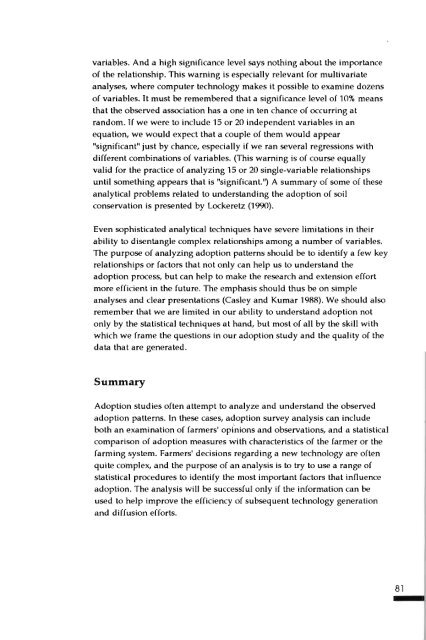The Adoption of Agricultural Technology - Food Security Group
The Adoption of Agricultural Technology - Food Security Group
The Adoption of Agricultural Technology - Food Security Group
You also want an ePaper? Increase the reach of your titles
YUMPU automatically turns print PDFs into web optimized ePapers that Google loves.
variables. And a high significance level says nothing about the importance<strong>of</strong> the relationship. This warning is especially relevant for multivariateanalyses, where computer technology makes it possible to examine dozens<strong>of</strong> variables. It must be remembered that a significance level <strong>of</strong> 10% meansthat the observed association has a one in ten chance <strong>of</strong> occurring atrandom. If we were to include 15 or 20 independent variables in anequation, we would expect that a couple <strong>of</strong> them would appear"significant" just by chance, especially if we ran several regressions withdifferent combinations <strong>of</strong> variables. (This warning is <strong>of</strong> course equallyvalid for the practice <strong>of</strong> analyzing 15 or 20 single-variable relationshipsuntil something appears that is "significant.") A summary <strong>of</strong> some <strong>of</strong> theseanalytical problems related to understanding the adoption <strong>of</strong> soilconservation is presented by Lockeretz (1990).Even sophisticated analytical techniques have severe limitations in theirability to disentangle complex relationships among a number <strong>of</strong> variables.<strong>The</strong> purpose <strong>of</strong> analyZing adoption patterns should be to identify a few keyrelationships or factors that not only can help us to understand theadoption process, but can help to make the research and extension effortmore efficient in the future. <strong>The</strong> emphasis should thus be on simpleanalyses and clear presentations (Casley and Kumar 1988). We should alsoremember that we are limited in our ability to understand adoption notonly by the statistical techniques at hand, but most <strong>of</strong> all by the skill withwhich we frame the questions in our adoption study and the quality <strong>of</strong> thedata that are generated.Summary<strong>Adoption</strong> studies <strong>of</strong>ten attempt to analyze and understand the observedadoption patterns. In these cases, a~option survey analysis can includeboth an examination <strong>of</strong> farmers' opfnions and observations, and a statisticalcomparison <strong>of</strong> adoption measures with characteristics <strong>of</strong> the farmer or thefarming system. Farmers' decisions regarding a new technology are <strong>of</strong>tenquite complex, and the purpose <strong>of</strong> an analysis is to try to use a range <strong>of</strong>statistical procedures to identify the most important factors that influenceadoption. <strong>The</strong> analysis will be successful only if the information can beused to help improve the efficiency <strong>of</strong> subsequent technology generationand diffusion efforts.81



